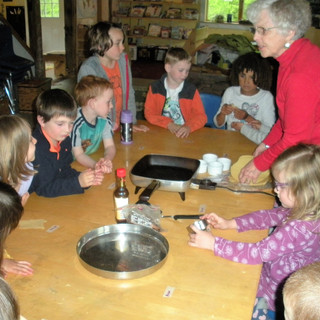Connecting Our Heads and Our Hands
- Tracy Manning
- May 29, 2017
- 2 min read
Young children like to grab on to their learning - dividing blueberries into equal shares, figuring out how to make the best ramps for their cars in the block corner, and tootling around on the recorder trying to find different notes. I like to grapple with big ideas, but we also try to come back to this physical grounding whenever possible. So we act out different situations when we are working on our emotional and social selves. We use all sorts of different manipulatives in math. We write words in shaving cream, changing the first letter to make rhymes and develop an understanding of phonics.
Bringing Math into the Physical World
Both the younger and older math classes have been playing with numbers using their whole bodies. Theresa wrote numbers on our sidewalk stones, and the children used these to practice counting up and down as well as addition and subtraction. All of the children were hopping, skipping, and jumping as they practiced math. The older children were doing a similar activity inside using big spots with a line of spots for the hundreds, tens, and ones places. We practiced our rote counting, saying and jumping from spot to spot. Then we built different numbers 374 is equal to 300 + 70 + 4. Then we took away or added a certain number of ones or a certain number of tens. It's the same sort of activity that we've been doing with little cubes, longs, and flats (the yellow blocks), and the children quickly made the connection. Figuring out how to take 215 and translate it into something physical helps everyone understand 215 better. Then we reverse the process, taking different physical representations and try to turn it into a numeral (1 hundred + 3 tens + 5 ones = 135).
Our Theme: India
We are very lucky to have two classroom grandmas who have traveled to India. They came in on Monday and Friday this week to share their experiences. The children handled different statues, tried on saris, sampled spices and foods, saw jewelry, looked at pictures, listened to stories, and even played the tabla (a special Indian drum). The children peppered their experts with questions and were eager to share what they have learned already. They connected these lessons with the books we have been reading and the movie that we watched this week "Families of India." They are both feeling connected to children living in this country on the other side of the world and appreciating some big differences in their lives.
We read The March to the Sea, a beautifully illustrated book about Mohandas Gandhi's famous march to protest Great Britain's tax on salt. It was one part of a much bigger movement, and we used our hundreds chart to figure out that it was 17 years from this march until India became independent of its colonial rulers. We talked about when someone might choose to break a law and how civil disobedience played a part in the civil rights movement in this country. The children also connected it to our own revolutionary war against the British. They have such a strong sense of justice and the need to treat people fairly - they get quite outraged on behalf of anyone not given equal treatment.
















































Comments